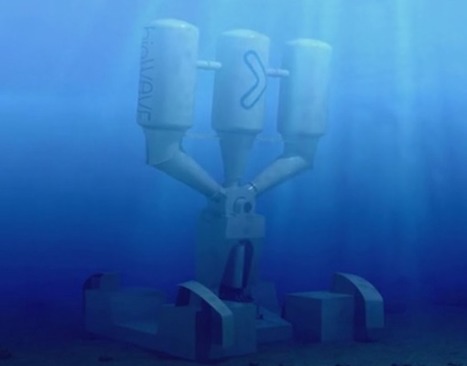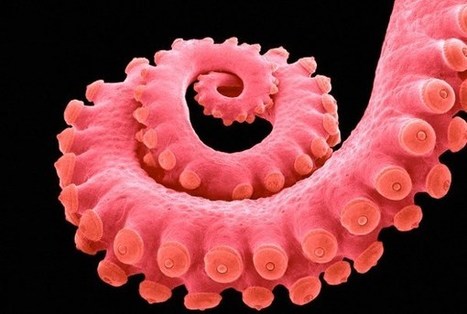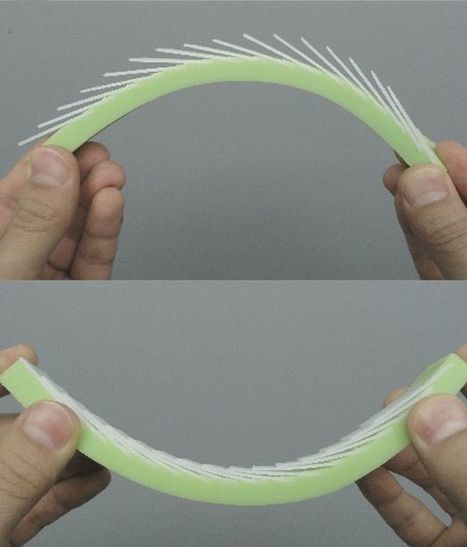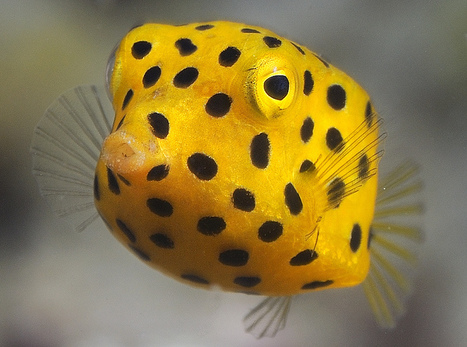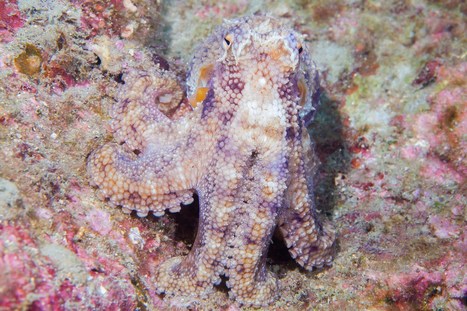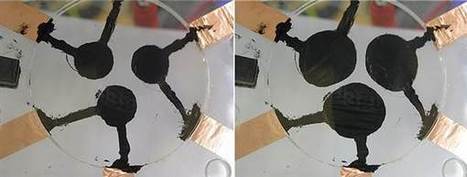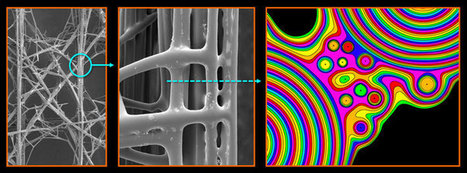 Your new post is loading...
 Your new post is loading...
"To build more aerodynamic machines, researchers are drawing inspiration from an unlikely source: the ocean. A team of evolutionary biologists and engineers at Harvard University, in collaboration with colleagues from the University of South Carolina, have shed light on a decades-old mystery about sharkskin and, in the process, demonstrated a new, bioinspired structure that could improve the aerodynamic performance of planes, wind turbines, drones and cars."
"Ribbon halfbeak are a species of fish with the ability to fly above the sea surface - but unlike true 'flying fish', they lack the necessary hind wing fins. So how do they fly? Dr Yoshinobu Inada from Tokai University, Japan says, "Investigating the design of ribbon halfbeak could provide useful information for the optimal design of tandem wing airplanes."
"From a whale shark keeping unwanted freeloaders off its skin to water droplets rolling off a duck’s feathers, nature has many ingenious ways of keeping surfaces clean. The science of biomimicry, or biomimetics, seeks to harness nature’s cleverest capabilities which have taken aeons to evolve. Scientists at AkzoNobel, a global paints and coatings company, are using principles derived from nature to develop coatings that protect surfaces such as the hulls of cargo ships. And other heavy industries such as rail are experimenting with biomimicry."
A biological material that has existed for millions of years may find new applications in modern electronics. A team of scientists from UC Santa Cruz, the University of Washington, and the Benaroya Research Institute at Virginia Mason discovered that shark “jelly” is the highest proton conductive biological substance ever found, according to GizMag. In plain English, that means the material is extremely good at detecting weak electrical signals from great distances away — something that scientists and engineers believe could be useful in future sensor design.
"Animal Dynamics, a company formed of biomechanics from the University of Oxford’s Department of Zoology, islooking to break the human-powered water speed record in a canoe propelled by an underwater fin, mimicking the way that dolphins or whales swim. The team believes that a flapping fin design could be a more efficient than a traditional propeller mechanism, as it works with the natural flow of water, rather than against it. Instead of using paddles, the catamaran-style canoe has a hydrofoil under its bow which is operated by a driver using a pedaling system. The cycling motion drives a fin downwards through the water, creating the thrust to propel the canoe forwards."
"A new bio-inspired method of harvesting energy from the ocean has completed its shakedown on land, and now it’s finally ready for its first real test offshore. Called bioWAVE, the wave energy device won’t be venturing too far — Port Fairy in Australia is as far as it’s going — but we can hardly contain our excitement because we’ve been waiting 7 years for this moment."
"NASA has chosen its next batch of proposals under its advanced concepts program, including the use of soft-robotic rovers for exploring gas-giant moons, and autonomous robots capable of crawling, hopping, and rolling around the surface of the Moon. [...] One of the more interesting proposals calls for a soft robotic squid/eel hybrid. The device would be equipped with a short antenna on its back to draw power from changing magnetic fields. The aquatic rover could be used to explore the subsurface oceans on Europa and Enceladus."
"Surgeries might be easier and safer due to a new invention by researchers from the Sant'Anna School of Advanced Studies in Italy, a robotic arm that was inspired by tentacles of an octopus. The robotic arm device moves by using its inflatable chambers, imitating the natural motion of an octopus twisting and elongating its tentacles in any direction it desires."
"Most of us were born and will die a certain color, but octopuses are masters of their hue, changing from transparent to shades of red, pink, purple and blue by stretching and relaxing their skin. If we could unlock their secret and wrap our buildings in octopus skin, then city skylines might shimmer a spectrum of colors and opacities as the sun waxed and waned."
"Another incredible adaptive animal and insect feature is the development of protective scales that provide insulation, and serve as a camouflage to ward off predators. In fact, animal scale functioning is so impressive that recently “dermal modification” — or the adaptive properties of animal skins — has inspired the scientific development of human armor using 3D printing."
Photo details: Octopus vulgaris, Comingio Merculiano, 1896. Wikimedia Commons, public domain.
"In 2005, Mercedes-Benz revealed a concept car with a strange shape. Called the Bionic, the cartoonishly snub-nosed vehicle was modeled after Ostracion cubicus, the yellow boxfish. Car manufacturers aren’t the only ones to take inspiration from this weird coral dweller. But researchers now say engineers who mimicked the boxfish might have been misled."
"Cephalopods are curious creatures, able to flex their bodies into nifty shapes and camouflage themselves from sight. Unsurprisingly, they have also been inspiring biomimicry-led designs for years because of this. This month a paper to be published in Nature Communications deals with their flexi-strechy skills and describes how man can now engineer an elastic film that lights up when stimulated using electricity. Meanwhile, a team of US material scientists has opted to create a new method of colour display using a technique they say will get us that much closer to the holy grail of cephalopod biomimicry studies: camouflaging "squid skin" that morphs into background shades automatically, (otherwise known as a metamaterial)."
|
A team of researchers from China and the U.S. has created a robot that is able to mimic a remora fish by adhering quickly and strongly to underwater objects.
"Using a mathematical model and the mackerel pectoral fin as an illustrative example, [...] researchers show how fin stiffness may be changed by applying a u-shaped curvature at the fin's base. The effect, the researchers say, might underlie the ability of fish to swim at widely varying speeds in all kinds of currents with great maneuverability. [...] The researchers say their model suggests intriguing possibilities for the design of robotic swimmers."
The mudskipper is a fascinating animal, in that it's a fish that both swims in the water and crawls on the land. It's probably not unlike the prehistoric fishes that first ventured out of the ocean, hundreds of millions of years ago. Looking at it, you might think that its two pectoral fins do all the work when it's out of the water, while its tail just flaps around. By building a robotic version of the mudskipper, however, scientists have learned that its tail plays a crucial role while it's on the land – the finding could have implications for the design of walking robots.
Filters can be found all around us, from our cars to our coffee makers. But they have one universal quality: they get clogged eventually. But a 3D printed solution could be just around the corner, as the Professor of Biology and ichthyologist Laurie Sanderson from the College of William and Mary has a patent pending for a bio-inspired alternative. Learning from the mouth structure of filter-feeding fish (using 3D printed models), she has developed a new mechanism that prevents filter clogging by trapping particles in vortices in the fluids.
It’s hip to be square if you’re a seahorse—or rather, it has certain adaptive advantages. Cylindrical tails may be much more popular in the animal kingdom, but the seahorse’s bizarre square-prism tail has far better mechanical properties.
The shifting colors on the skin of cuttlefish and other cephalopods could lead to bio-inspired camouflage and signalling, researchers say.
The European Union CoCoRo research consortium has been developing three varieties of autonomous underwater robots that school together like fish. By doing so, the little bots can share and learn from each others' "knowledge" of their environment, acting as a collective cognitive system.
"Scientists often look to biology for inspiration and innovation, emulating the way that nature builds to advance human engineering. Creatures of the ocean's depths are some of the most mysterious and fascinating subjects for study, due to the challenges of collecting them from very deep waters and for their unique adaptations for colonizing the sea floor. One such group is the hexactinellids, a collection of predominantly deep-sea sponges that produce elaborate skeletal systems of glass. Known as glass sponges, over the years their skeletal systems and their constituent elements (called spicules) have served as useful model systems for the design and fabrication of robust and damage tolerance."
"..an MIT/Harvard study suggests that a specific type of limpet's shell may hold the key to transparent displays that require no internal light source. The mollusk in question is the blue-rayed limpet which, as its name implies, has bright blue stripes on its translucent shell. It is believed that these are used to make potential predators mistake it for a poisonous snail, which also has blue markings. The iridescent lines appear blue due to the fact that the shell material in those areas reflects the blue spectrum of incoming light, while absorbing other colors so that they don't drown out the blue."
"Engineers in the UK have found that limpets' teeth consist of the strongest biological material ever tested. Limpets use a tongue bristling with tiny teeth to scrape food off rocks and into their mouths, often swallowing particles of rock in the process. The teeth are made of a mineral-protein composite, which the researchers tested in tiny fragments in the laboratory.They found it was stronger than spider silk, as well as all but the very strongest of man-made materials. The findings, published in the Royal Society's journal Interface, suggest that the secret to the material's strength is the thinness of its tightly packed mineral fibres - a discovery that could help improve the man-made composites used to build aircraft, cars and boats, as well as dental fillings."
"When you inflate a balloon and then release it without tying the valve shut, it certainly shoots away quickly. Octopi utilize the same basic principle, although they suck in and then rapidly expel water. An international team of scientists have now replicated that system in a soft-bodied miniature underwater vehicle, which could pave the way for very quickly-accelerating full-size submersibles."
Studying the movements of creatures in the natural world is very useful to robotics as the latest version of a robotic octopus from Greece shows. But real octopodes could also learn from their robotic cousin, which uses its octopus-inspired anatomy to propel itself in new ways.
|
 Your new post is loading...
Your new post is loading...
 Your new post is loading...
Your new post is loading...











